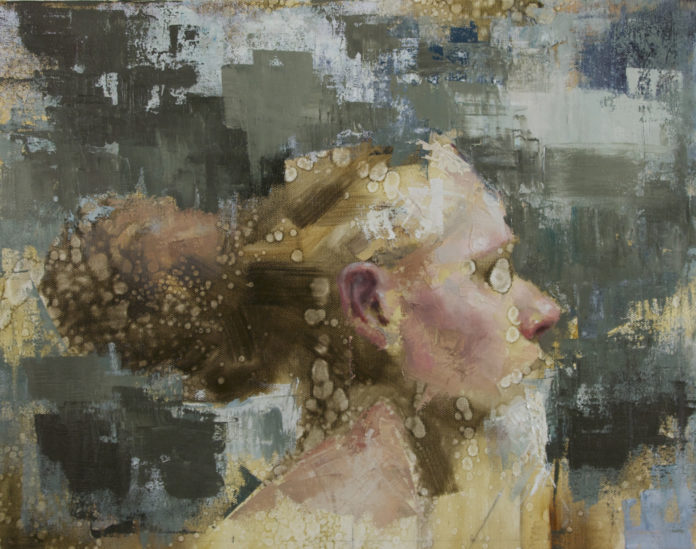“How do they do that?” Enjoy a behind-the-scenes look into how the process of creating art, including the “unfinished” pieces, becomes the finished work for this portrait / figure painter.
More Than Process
BY JOHN WENTZ
At some point I realized I have always had a preconceived idea of how I wanted a painting to look. Even before I bought or stretched the canvas, I knew what I was trying to achieve with the finished result. Sketches were really just for placement and values. None of the linear elements, or the graphite medium for that matter, would make it into the painting. It was just shorthand. After all, it was how I was taught and what I thought painting was.
In school, we were taught by copying the old masters and appropriating the new ones. By this method, you were painting with an end game in mind. This, of course, is by no means easy, but the process involved is really just the road to getting somewhere. This was fine for awhile, but in time I began to feel that my experience in painting was lacking something.
One day, feeling unsatisfied with my work, I turned to an old sketchbook. On the first page I read some words I had jotted down: “Style is embedded in process.” This was a quote from Chuck Close that I had completely forgotten about, and it couldn’t have found its way back into my life at a better moment. It wasn’t that I was looking for a style, but I realized that maybe I was putting the cart before the horse. Maybe it would be interesting to focus only on process and see where the painting went.
With this shift, I found myself looking only at abstract art. Non-objective and Abstract Expressionist artists can be very process oriented and experimental with their tools and mediums. Their works are treasure troves of inspiration in mark-making vocabulary for us representational artists.
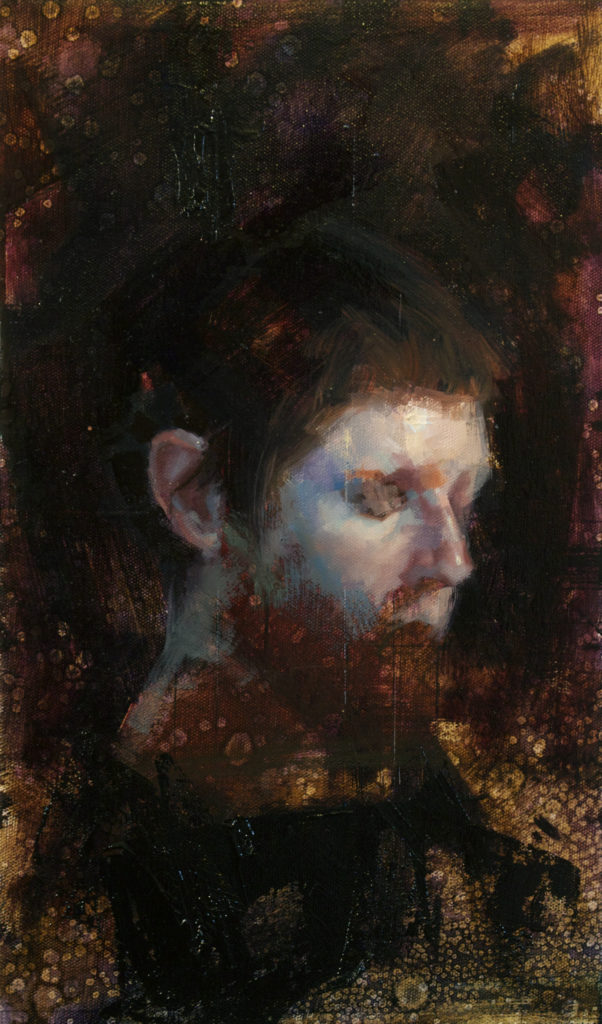
I quickly became obsessed with my materials and their possibilities in a way I never had before. Standard brushes were set aside for more unconventional tools. I even began working with paintings on the ground as opposed to on an easel. At first, it was a total disaster. However, I experienced something I hadn’t in a long time: fun, and a sense of exploration and discovery.
I began with portraits and went in with the idea of economy. I wanted to use as little as possible to get a result. I limited my palette to primaries and some earth tones and only allowed myself two brushes and a palette knife. With limited choices, I found that each step in the process was creative exploration and problem solving.
I started with my familiar approach, toning the canvas an earth tone, but tried adding textures to make just that one stage interesting. I dropped medium onto the wet surface of umbers and siennas as little pools of splotches appeared, making the canvas look like a topographic map. Because these initial layers were transparent paint, my preliminary drawing and compositional grids showed through like a ghostly blueprint.
This stage alone began to look like an interesting abstract painting, with each step of the process adding depth and design. As I began painting the figure, I found that I wasn’t as much concerned with the model and likeness as I was about enjoying the interplay between the opacity of this new layer and the transparency of the first layer. In this sense, it became very abstract—the process and the materials predicated every decision I was making, rather than the end game of depicting a human in paint. Because of this, it didn’t seem necessary to paint the model in her entirety. In fact, it seemed more interesting to leave features out or to abstract them.
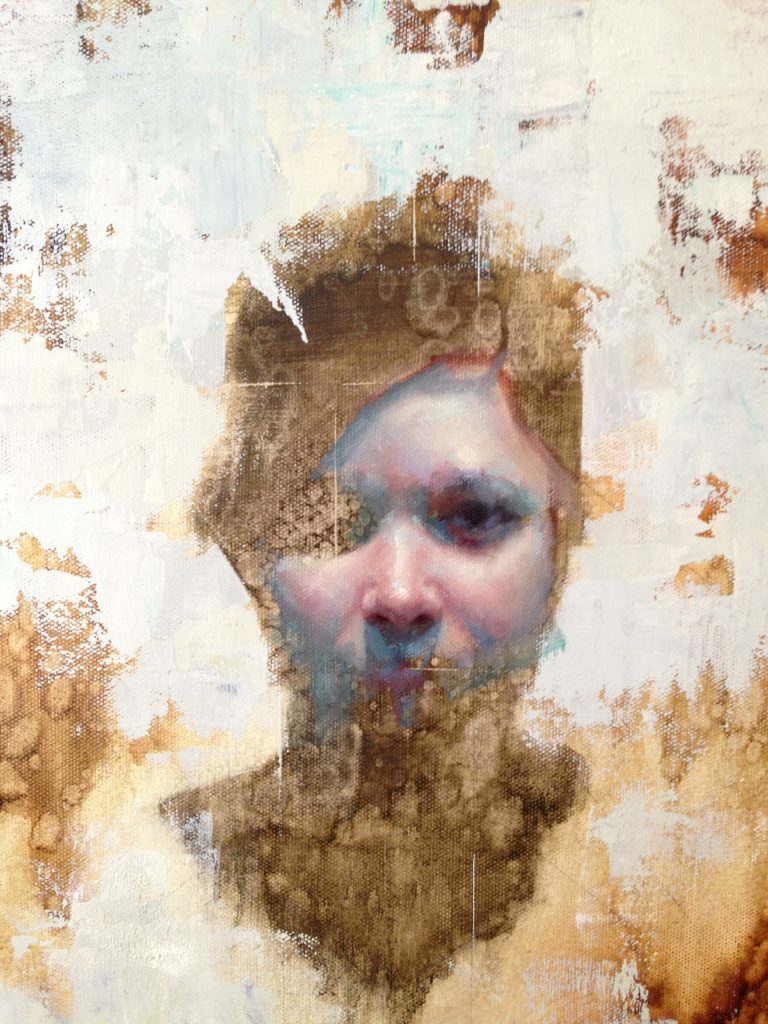
This was a matter of repeatedly stepping back to judge all of the information as a whole, taking into account all of the formal qualities of balance, value pattern, focal point, etc. The composition grew and evolved with each new mark and passage.
I later came to believe that leaving information out, unfinished or abstracted, invites the viewer to participate in the image, just as simplifying does. But also disclosing less information allows the viewer to project themselves onto the picture, in some sense making them “vulnerable” and open to experience something more personal and emotional.
As I continued painting, the process evolved into this routine of establish, lose, re-establish. In continuing to measure, I found myself needing a line from the compositional grid, so I would “redraw” with a palette knife. This resulted in a few sharp lines like notes on a staff paper, which added to the picture in some way that I knew I just liked. It was later that I realized what I enjoy is to have the history of the process as the final image, with each mark having a purpose or intention.

After experimenting with painting the head, I found that I really wanted to work with more of the figure, especially multi-figure. People in groups have always fascinated me both psychologically and as form. I thought the cluster of shapes would lend itself to interesting compositions with this process and allow for more experimentation with materials and paint application.
The experience with multiple figures was quite a challenge, but the process was much the same. So I tried to play around again. This time for the initial layers, I tried using a variety of colors. I had many tubes of paint that I had never used so I thought, why not? Fully saturated blues and greens found their way in with the umbers and siennas.
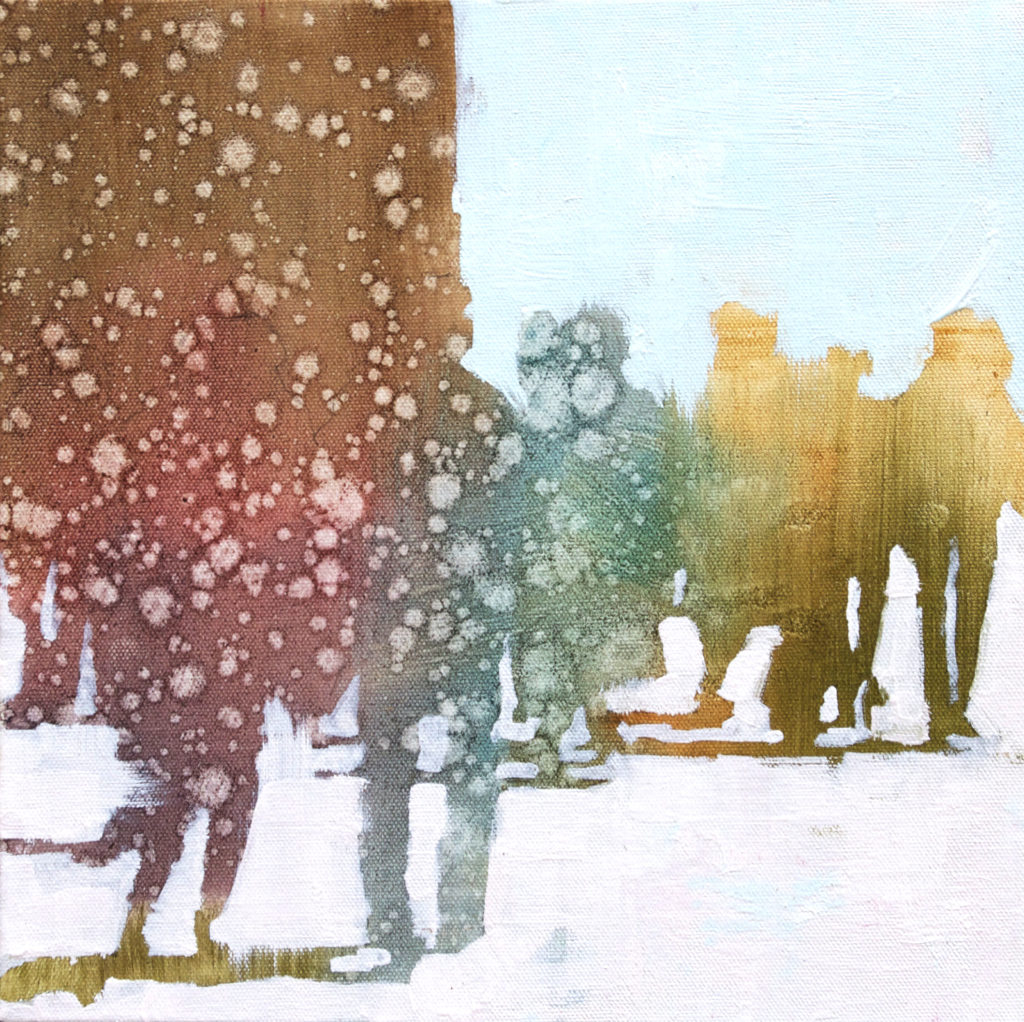
I worked first with some small studies, a palette knife and a house painting brush. I enjoyed the look of this stage so much I couldn’t bring myself to paint over the figures. Instead, I just painted the background in heavy impasto layers of gray-greens, which contrasted nicely with the transparent negative shapes of clustered figures weaving in and out of each other on the city streets. It seemed to reflect the feeling of losing one’s identity amongst a big crowd in a city. We are no longer the individual, but just a part of a group. This led to a series of paintings I titled “Abstractions.”
Since the “Abstractions” were small—12 x 12 inches—I decided to see how this would translate to larger pieces. 40”x40” seemed like a good starting place. With the variety of colors in the toning stage, standard flesh tones didn’t seem to work as well on this larger scale. Again, in the spirit of simplification, I limited my palette to a cool blue-black. The warm undertone had a very appealing contrast against the cool foreground of figures.
It also had this quality of “illumination” that I really liked. Still, the idea of color in the figures still appealed to me, so I switched the first layers back to earth tones and let the process grow from there. This built into a series of works I called “Passages.” Here are some examples:
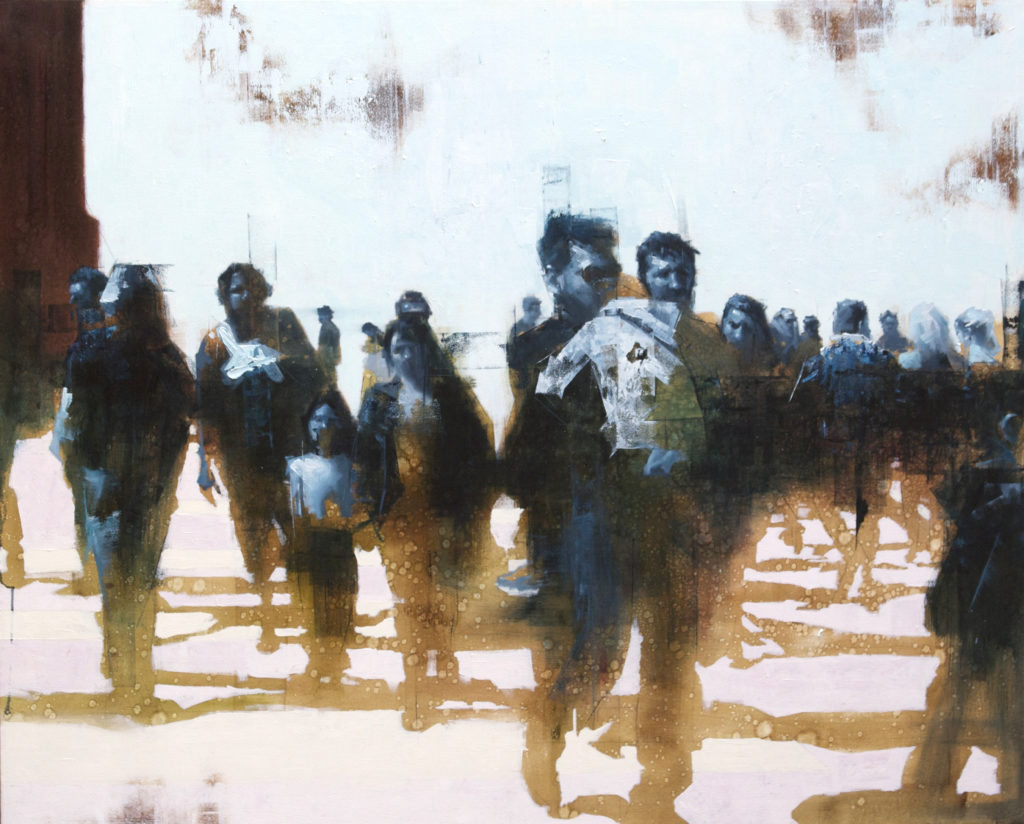
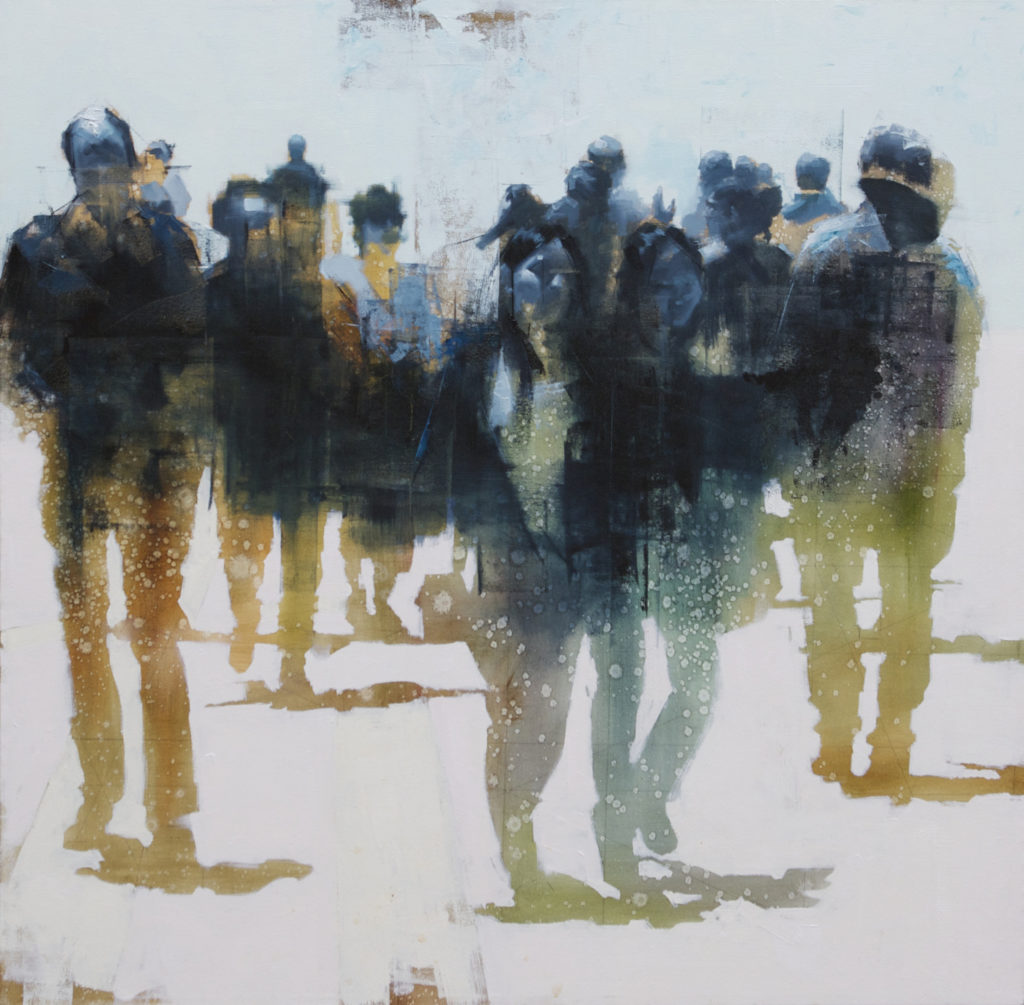
At the same time, I was taking this new approach of toning in saturated color back to portraits. The intimacy and quietness of portraiture has always appealed to me. But what’s really interesting to me about a portrait is that not only is it a portrait of a person, but also a portrait of an emotion, so to speak. There’s something about the modesty of a solitary person that can be very powerful.
Due to the variety of colors and their strengths in the initial toning stage, it was still difficult to see my preliminary graphite drawing. Instead of redrawing with a paintbrush, I decided to use a palette knife and pure black. The harsh, razor-sharp lines were fascinating and abrupt. It felt more like sculpting than drawing. I then tried using oil pastels to find quick gestures, which further evolved the process of establish, lose, re-establish—adding something new and interesting every time.
For the figure itself, I found my favorite brushes were brights. The rectangular strokes they left were harshly geometrical and a great contrast to the circular splotches in the undertone and the curvilinear liveliness of the gesture lines in oil pastel. If not applying with a brush, then passages were applied with the scraping of a palette knife, building thickness and texture. In building up the figure, I was more interested in the physicality of the paint and its tactile sensibility.
The fact that it was a person was almost secondary; a likeness, tertiary. The idea of how much detail or information to disclose was determined by the relationship of each stage to the other, building everything up like an abstract painting.
Each stage of the process became its own passage with line playing against tone, transparency against opacity, texture against smoothness and warm against cool. This led to another body of work: “Imprints.”
With each piece I really began to appreciate and trust pure process. It felt that in each stage there was an honest form of expression. In a sense it’s constructing rules for yourself. You create your own problems, and then find your own solutions. The process became part of the finished work; each stage left “unfinished” is a history of the process. Yet it all comes together in some sort of symphony of contrasts. And as finished pieces, I suppose there is a certain “style” that has been found, but that was almost incidental. At least, it wasn’t the goal. As the journey can be the destination, the process can be the art.
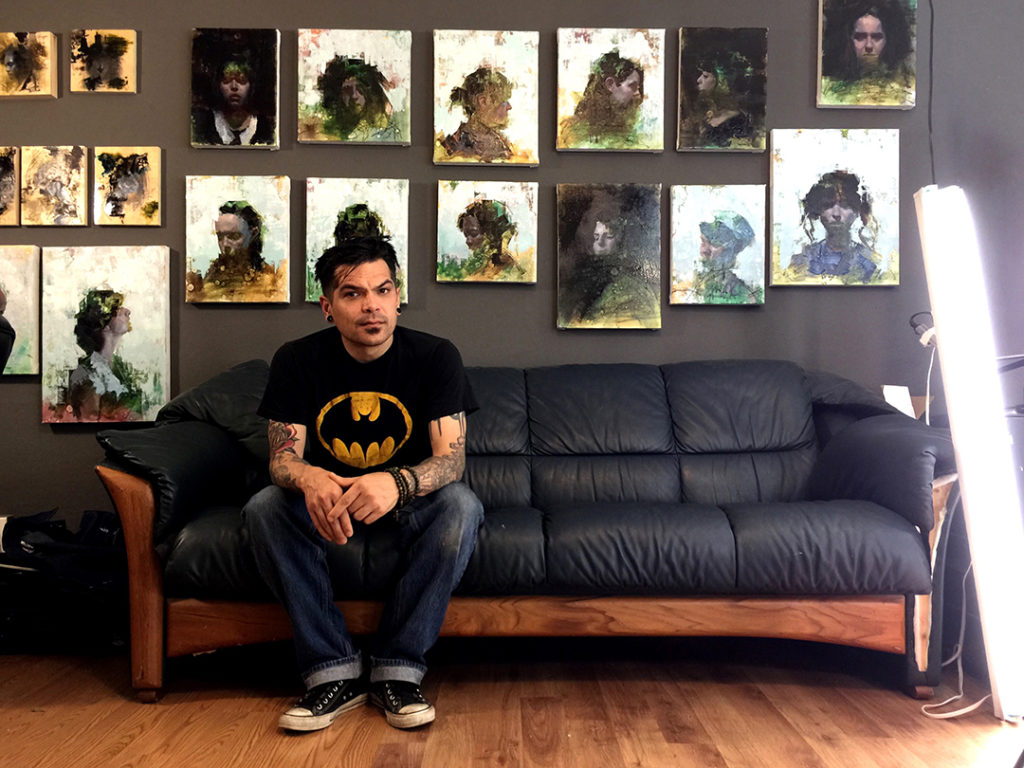
Learn more about John at: www.wentzart.net
> Visit EricRhoads.com to learn about more opportunities for artists and art collectors, including retreats, international art trips, art conventions, and more.
> Sign up to receive Fine Art Today, our free weekly e-newsletter
> Subscribe to Fine Art Connoisseur magazine, so you never miss an issue

